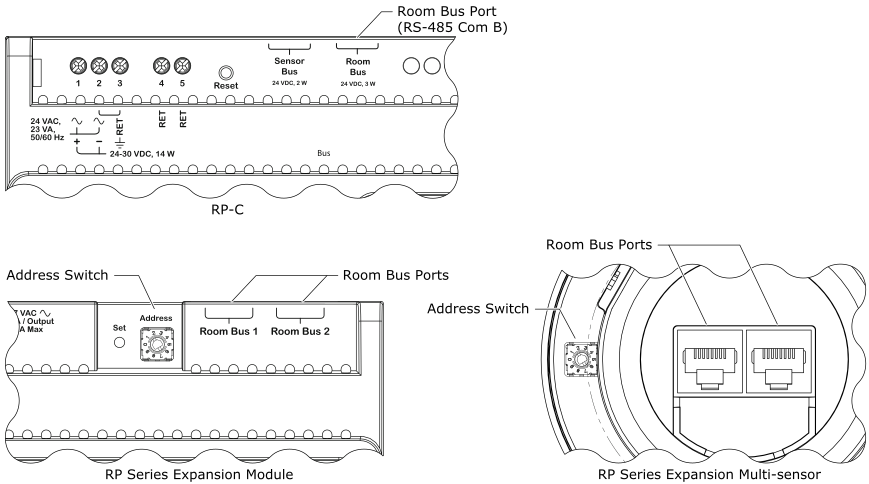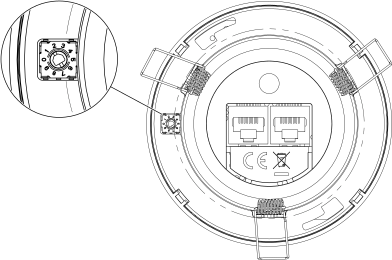The RP-C room bus allows RP Series expansion modules and multi-sensors to be connected to the controller for motion detection, luminosity measurements, communication with remote control (RP-C-RC-BLE), and control of electric lights and window blinds.
The maximum total length of the room bus is 72 m (236 ft). The room bus uses a Cat 5 (or higher) unshielded, straight-through wired cable with eight conductors (four twisted pairs) and RJ45 connectors. The wire size (cross-sectional area) should be 22 to 26 AWG (0.34 to 0.14 mm²). When the RP-C controller is installed in a space that handles conditioned air or return air, the room bus cables and IP network cables frequently must be plenum-rated to meet applicable building codes.
For more information, see Wiring
.
|
Notice
|
|
LOSS OF COMMUNICATION
Ensure that the total length of the room bus does not exceed 72 m (236 ft).
Use a Cat 5 or higher unshielded twisted pair cable with eight conductors (four twisted pairs), a cross-sectional area of 22 to 26 AWG (0.34 to 0.14 mm
2
), and a rating that meets the requirements of the target environment.
Failure to follow these instructions can result in loss of communication.
|
By default, the RP-C controller's Room Bus port (RS-485 Com B) is configured and allocated for the room bus.
For more information, see RP-C Communication Ports
.
action_zoom_plus_stroke

Figure:
Location of the Room Bus ports and address switches on the RP-C controllers and RP Series expansion modules and multi-sensors
You can connect a single RP Series expansion module or multi-sensor to the room bus, or you can connect up to six devices in a daisy-chain configuration.
Note:
When connecting devices to the RP-C room bus through a daisy-chain configuration, it does not matter if the incoming and outgoing cables are connected to one or the other room bus port on the device.
The RP-C room bus supports up to six connected RP Series expansion modules and multi-sensors with the following restrictions:
Maximum of two DALI light modules
Maximum of two SMI blind modules
Maximum of four multi-sensors
action_zoom_plus_stroke

Figure:
Example of supported combination of RP Series expansion modules and multi-sensors on the RP-C room bus
Each RP Series expansion module and multi-sensor has a rotary switch, which is used to give the device a unique address on the room bus. An RP Series expansion module or multi-sensor can be given any address in the range of 1 to 6. Configuring the address 0 means that the device enters maintenance mode and goes offline. Configuring an address in the range of 7 to 9 also means that the device goes offline.
For more information, see RP Series Expansion Module Room Bus Addressing
. An incorrectly configured switch can cause two devices to have the same address on the room bus, which means that both devices will be offline.
|
Notice
|
|
LOSS OF COMMUNICATION
Ensure that the rotary switch on the RP Series expansion module or multi-sensor is configured to give the device a unique room bus address in the range of 1 to 6.
Failure to follow these instructions can result in loss of communication.
|
Table: Room Bus Addresses
|
Address
|
Description
|
|
0
|
Maintenance mode. Device offline.
|
|
1 to 6
|
Valid addresses supported by the EcoStruxure Building Operation software.
|
|
7 to 9
|
Reserved for future use. Addresses not supported by the EcoStruxure Building Operation software. Device offline.
|
Note:
Devices connected to the RP-C room bus through a daisy-chain configuration can be assigned addresses regardless of the order in which the devices appear in the daisy chain. For example, device number 1 can have the address 6, device number 2 can have the address 4, and so on.


 RP-C Room Bus
RP-C Room Bus
 RP Series Expansion Module Room Bus Addressing
RP Series Expansion Module Room Bus Addressing

